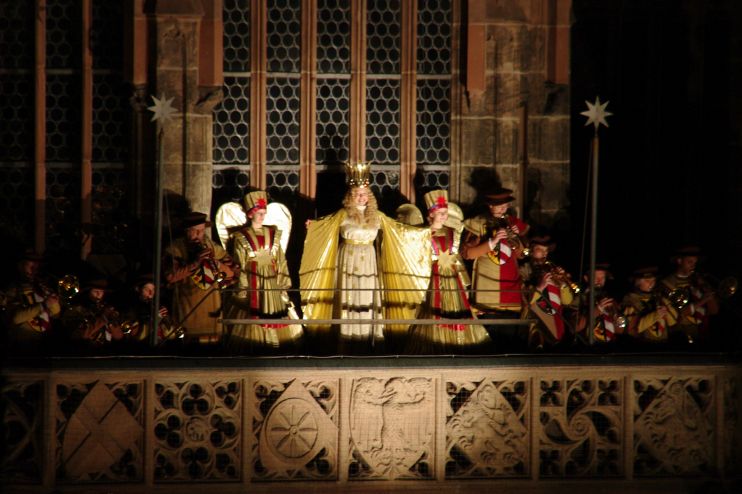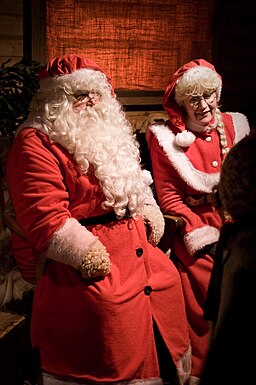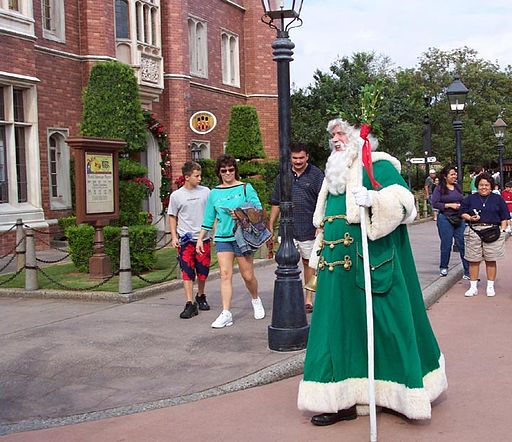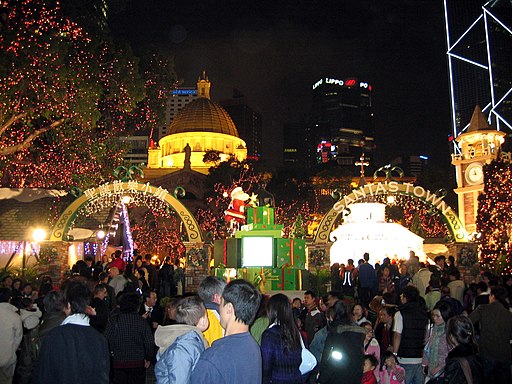So the other day Hazel came home from school and told me she had been arguing with some of her friends at school about whether Santa Claus is real or not. She asked who was right. In the past (maybe November) I told her Santa Clause only brings gifts to children who believe in him. She grew very concerned that one of her friends at school did not believe in him so she wouldn't get any gifts. At almost six I didn't want to ruin the magic for her, but I was not going to lie to her face. We had a discussion of how she learned about St. Nicholas in her old Waldorf School and how Santa Claus came from his stories. However since St. Nicholas is no longer alive there really is not a Santa Claus alive, so Mommy and Daddy buy the gifts from him since the spirit of Santa Claus is really part of the holiday spirit. She took this information and decided she was right--there is a Santa Claus. The next day she wanted to get her picture with Santa again at the mall when we were there (though she did tell this Santa that she already told the Santa at the other mall what she wanted for Christmas and he did not know what to say to that).
Of course I should add that the two Santas looked very different from each other. Having just written the history of Christmas trees and Christmas tree traditions around the world post, I was curious as to the Santa Clauses or Gift Bringers from around the world. I of course turned to two of my favorite sources for information, Multicultural Kid Blogs bloggers and the library!
History of Santa Claus
 |
| St. Nicholas of Myra See page for author [CC BY 4.0], via Wikimedia Commons |
 |
| Sinterklaas by Gaby Kooiman [GFDL, CC-BY-SA-3.0 or CC BY-SA 2.5], from Wikimedia Commons |
Prior to Christianity, the Germainic people celebrated a midwinter event known as Yule. During this time it is believed there was a Wild Hunt where the spirits had a procession through the sky led by the god Odin. Some believe it is from Odin that Santa Claus got his long white beard and the legend of riding at night. Odin was also known to enter houses through the chimney. The modern image of the American Santa Claus is said to come from the Dutch image of Sinterklaas. In England Father Christmas dates back to the sixth century during the reign of Henry VIII. He was pictured as a large man dressed in scarlet or green robes. Since England no longer celebrated St. Nicholas's Feast Day, Father Christmas was moved to December 25. The name Santa Claus was first used by the American press in 1773. The color of Santa Claus's clothes depends on the country. The American origin is said to be from an advertisement for Coca Cola since the company colors are red and white. However the red and white combination was used prior to that advertisement as well. (Source)
Gift Bringer Traditions Around the World
United States
In the United States Santa Claus makes his annual visit to children around the world on the night of December 24. He travels by a sleigh pulled by eight reindeer who can fly. He comes down the chimneys and leaves gifts in stockings hung by the fireplace as well as under the tree.
 |
| Our Stockings Hung by Fireplace |
The children visit Santa Claus at the local malls and many public and private places. Pictures with Santa are very common for most young children. He arrives at the malls shortly after Halloween. He is always dressed in a red suit with white fur trim. He has a large stomach and a long white beard and glasses. The children also write letters to Santa Claus to tell them what they want for Christmas and they leave cookies and milk for Santa as well as a carrot for the reindeer on Christmas Eve.
Puerto Rico and Many Latin American Countries
In Puerto Rico and many Latin American Countries, the gift bringers are the Three Wise Men from the Christmas story. They bring gifts for the Epiphany, January 6th. January 6th is known in the Spanish speaking Latin American countries as El Dia de Reyes. Frances at Discovering The World Through My Eyes shares that the children leave water and grass for the camels on the night of January 5th. The Wise Men come and leave gifts for the Wise Men's camels. She also shares that in Puerto Rico children can get pictures with the Wise Men. Frances also shares a round-up of books that discuss celebrating Three Kings Day (Epiphany). She also shares many ideas for celebrating the day from baking, cultural play dates and crafts!
 |
| Family in Mexico Posing with Wise Men By Thelmadatter (Own work) [CC BY-SA 3.0 (http://creativecommons.org/licenses/by-sa/3.0)], via Wikimedia Commons |
In Mexico the children leave their shoes outside filled with hay or grass on January 5th. Another tradition on Epiphany is to eat Rosca de reyes or kings' cake. They are often oval in shape and have a small trinket (Christ child doll) hidden in them. (In Argentina the trinket is not hidden.) The cakes are decorated with figs, cherries, candied fruit and nuts. Hiding the baby in the cake is to represent the flight of the Holy family to Egypt when King Herod wanted to kill Baby Jesus. Whoever finds the baby in Mexico has to bring the baby to church on February 2nd, Candlemas Day and has to host a dinner of tamales and atole for guests. (Source)
 |
| Rosca de Reyes By Thelmadatter (Own work) [CC BY-SA 3.0], via Wikimedia Commons |
Poland
| Święty Mikołaj By Silar (Own work) [CC BY-SA 3.0 or GFDL], via Wikimedia Commons |
Another gift bringer in Poland is Gwiazdor or Star Man. He comes on Christmas Eve and is very much like the American Santa Claus. Olga could not go into length on him. Traditionally he wore a fur cap of sheepskin and a mask or his face was covered in soot. He carried a sack of gifts and a rod. He knew if children had been bad or good and he either gave a gift if the child was good or beat the child with the rod if he/she was bad. (Source)
The Netherlands
 |
| Sinterklaas By Michell Zappa] ([1]) [CC BY-SA 2.0], via Wikimedia Commons |
 |
| Sinterklaas Arrival By Ad Meskens (Own work) [CC BY-SA 3.0 or GFDL], via Wikimedia Commons |
 |
| Bram van der Vlugt Als Kerstman By Pau!l (Pau!l) [CC BY-SA 3.0 nl], via Wikimedia Commons |
Russia
 |
| Ded Moroz ("Дед Мороз" in Russian) By Sergeev Pavel (Own work) [Public domain], via Wikimedia Commons |
 |
| Ded Moroz and Snegurochka By Yogi555 (Own work) [Public domain], via Wikimedia Commons |
France
 |
| Picture with Père Noël provided by Vicki Lesage, Author |
| "French Santa" by Jacob Windham from Mobile, USA - Flickr.com - image description page. Licensed under CC BY 2.0 via Wikimedia Commons. |
There is also Petit Noël in France. Petit Noël visits the parts of France that
Père Noël does not. Petit Noël represents the Christ Child and brings gifts Christmas Eve. The French also have parties for the Epiphany or The Fest of the Kings. (Book Source 1)
Switzerland
 |
| Santa on Skis in Switzerland By Norbert Aepli, Switzerland (noebu), color and contrast edit by Lucas (Own work) [CC BY-SA 2.5], via Wikimedia Commons |
 |
| Christkindli By Roland Berger (Own work) [CC BY-SA 3.0 or GFDL], via Wikimedia Commons |
Christkindli means Christ Child. Originally it was believed that Jesus brought the gifts. Now Christkindli is usually represented as an angel. The Swiss leave a window open so Christkindli can enter the house on Christmas Eve. Some Swiss also celebrate St. Nicholas Day. (Book Source 1)
Italy
 |
| Babbo Natale By Alan Denney (Flickr: Piazza Duomo 1981) [CC BY 2.0], via Wikimedia Commons |
Ute of Expat Since Birth also shares in Italy Santa Claus is called Babbo Natale. Babbo Natale seems to look like the other Santa Clauses and he brings gifts on Christmas Eve. There are pictures in the malls and at parties. Giuliana, a member of Multicultural Kid Blogs, shared that in Italy they leave a couple of clementines and a glass of red wine for Babbo Natale on Christmas Eve.
 |
| La Befana By ho visto nina volare [CC BY-SA 2.0], via Wikimedia Commons |
Germany
 |
| Knecht Ruprecht und das Christkind See page for author [Public domain], via Wikimedia Commons |
Ute of Expat Since Birth also shares in Germany there are different names for Santa Claus depending on if you are north or south. Weihnachtsmann is the name in Northern Germany and Christkind is the gift bringer in Southern Germany. Traditionally St. Nicholas Day was celebrated in Germany, but with religious changes St. Nicholas began to look like the American Santa Claus and started bringing gifts Christmas Eve. However there are still stories of St. Nicholas's companion, Knect Ruprecht as well as some other names for St. Nicholas like Krampus and Pelzebock. (Book Source 1) Christkind represents the spirit of the Christ Child and passes out presents at parties. (Book Source 2)
Finland
 |
| Joulupukki By Anssi Koskinen (originally posted to Flickr as pukki ja muori) [CC BY 2.0], via Wikimedia Commons |
Rita from Multilingual Parenting shares that in Finland Santa Claus is called Joulupukki. Joulupukki comes into the house and dances with the children or he leaves the gifts at the door and runs. If there is snow and the parents paid extra for it, Joulupukki may come with a reindeer sleigh. He always comes Christmas Eve. Pictures can be taken while he is visiting.
Joulupukki means yule goat and is sometimes called yule buck. Some legends have him as half man and half goat on Christmas Eve. He originally demanded presents instead of giving them out, but today is more like the American Santa Claus. (Source & Book Source 1)
United Kingdom/England
 |
| Father Christmas By Jacob Windham (Flickr.com - image description page) [CC BY 2.0], via Wikimedia Commons |
In the United Kingdom it is Father Christmas who brings gifts on Christmas Eve. Traditionally Father Christmas is portrayed as a large man in flowing robes of green or scarlet and has holly or mistletoe leaves in his white hair. He may also appear giant and have a yule log or Christmas bowl of punch in his hands. Nowadays he is portrayed like the American Santa Claus, but is still associated with the ancient gods Saturn and Odin. (Book Source 1) According to Stephen from The Head of the Heard, children leave mince pies and beer for Father Christmas on Christmas Eve.
Spain
 |
| Tió de Nadal By Slastic (Own work) [Public domain], via Wikimedia Commons |
Australia
 |
| Australian Stamp Source |
In Australia and the Southern Hemisphere, Christmas is in the summer. In Australia Santa sometimes rides onto the beach on a surfboard. Such a strange image for Americans to imagine. (Book Source 2)
China
 |
| Christmas in Hong Kong By WiNG (Own work) [CC BY 3.0], via Wikimedia Commons |
In China the children hope Dun Che Lao Ren, Christmas Old Man, will come fill their stockings with gifts. Christmas in China is celebrated with bright lights and Christmas trees are called light trees. (Source & Book Source 2)
Books
Now as I mentioned I turned to the library for books to research this post and to share the stories with Hazel. Here are some of the books we found. Some are definitely just stories, some are for older children or longer and others were really informative in a way Hazel could learn.Book Sources
I used two books to help write this post. Book Source 1 is Santas of the World by George Ouwendijk and Book Source 2 is Christmas/Navidad by Bonnie Hinman.
For more Multicultural Christmas posts check out:
- Christmas in Different Lands: Christmas in New England
- History of Christmas Trees and Christmas Tree Traditions Around the World
- Craft It Up! Christmas Around the World Book Review
- Exploring Ukraine
- Multicultural Christmas Books
- Christmas in Jamaica
- Christmas in Kenya Part 1 and Part 2
- Christmas Around the World and Other Holidays






